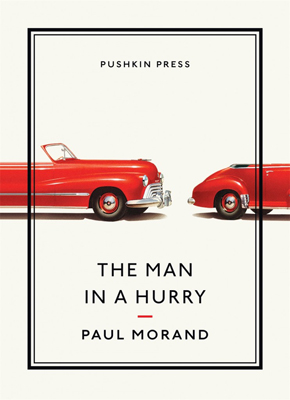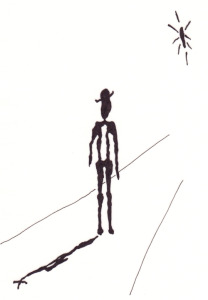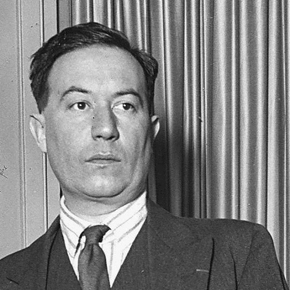Fleet of word and deed
by Mika Provata-Carlone
“A pioneer craftsman of Modernist French prose.” New York Times
We know perhaps too much about Paul Morand, and certainly too little. Distillations of his being, his writer’s essence and his place in history most often focus on his celebrated friendships with Chanel and Proust, his occasionally bombastic, somewhat affected and at times self-glorifying public persona, his casual intolerance of much that did not conform to an unclear definition of the word ‘pure’. For certain critics, he is perhaps morally dubious, or at best ethically oblivious, as attested by his association with the Vichy government, an association which nonetheless limited itself to preserving a VIP presence in political and public life, a lifestyle of high-society receptions, steamer trunks, exquisitely crafted suitcases and streamlined trains, aeroplanes, yachts and cars.
Paul-Émile-Charles-Ferdinand Morand was the son of Eugène Morand, a prominent civil servant and painter. He belonged to a comfortable middle class with more aspirations than credentials, burgeoning bohemian inclinations, a rich culture, and strong, fertile links with artists, musicians and writers. Eugène Morand was the director of the School of Decorative Arts and translated Hamlet for Sarah Bernhardt. Paul Morand grew in her company, as well as in that of Auguste Rodin and Camille Claudel, the Symbolist writer Marcel Schwob (adored by Borges and Bolaño) and the actress Marguerite Moreno. Not quite at the top of his class at school, Morand learned English, read Political Science at Oxford and joined the diplomatic corps, where he made a life-long career both abroad and in the French Home Office. His was a world of speed and power, whirling social calendars, swift decisions and fading, fleeting memories of the consequences of actions.
Morand was as ambiguous in his own life as he was indisputably influential as a writer, as the architect of a modern style and aesthetics, almost of a new French language. One must see him as a member of his generation, in contrast to or in parallel with its movements, trepidations, its astonishing or shocking new grounds. Its Vile Bodies, Waste Lands, Brave New Worlds or century-old Ithacas. He claimed Schopenhauer and Nietzsche as his early influences, Misia Edwards Sert as his muse and guide to the spirit of the times. He struggled with the allure of psychoanalysis which he could neither escape nor embrace, stood between Dada and surrealism, ahead of experimentation, and, according to Roger Nimier, Michel Déon, Antoine Blondin and Jacques Laurent, the ‘Hussards’ of the 1950s and 1960s who brought him back in the public eye, behind all new French writing.
Morand’s works are about cold memory and perforating perception. They are about instinct and the senses as opposed to the mind, reflection and emotion.”
And this is indeed the unyielding, indomitable and permanent truth about Paul Morand. He is one of the finest writers, the finest craftsmen in his language, a master of the short story form which he revived, redefined and reinstated. He gave back to French words and writing grit and muscle, lyricism as well as novelty.
Morand’s works are about cold memory and perforating perception. They are about instinct and the senses as opposed to the mind, reflection and emotion. They are about greed and dignity, women, speed and immobility, night and day. They probe the new realities of internationalism, globalisation, nationalism and the loss of individual traits and outlines.
 The Man in a Hurry is one of Morand’s most successful books, a novel that each generation in France has claimed as its own. It is the story of Pierre Niox, a somewhat successful antiquarian, a man in love with the musty, dusty, obscure and slow Carolingians and the year 1000 ad, and at the same time in the greatest, most uproarious haste to reach, ahead of time, not mere modernity but futurity, the year 2000 ad, let’s say, although 3000 ad would be infinitely better. Pierre is in every way modernity personified. He lives with such intense alacrity, thinks so expediently, conceives of existence with such rapid and intrepid acuity, that he in fact fails to catch up with his own velocity. He runs so fast ahead of himself, through the fabric of his life, that his own life leaves him far behind.
The Man in a Hurry is one of Morand’s most successful books, a novel that each generation in France has claimed as its own. It is the story of Pierre Niox, a somewhat successful antiquarian, a man in love with the musty, dusty, obscure and slow Carolingians and the year 1000 ad, and at the same time in the greatest, most uproarious haste to reach, ahead of time, not mere modernity but futurity, the year 2000 ad, let’s say, although 3000 ad would be infinitely better. Pierre is in every way modernity personified. He lives with such intense alacrity, thinks so expediently, conceives of existence with such rapid and intrepid acuity, that he in fact fails to catch up with his own velocity. He runs so fast ahead of himself, through the fabric of his life, that his own life leaves him far behind.
Pierre is engaged in sharp, crystalline dialogue with Zachary Regencrantz, a Jewish doctor bereft of a passport and a homeland, a Rosencrantz to this enigmatic, ephemeral and incandescent 1930s’ Hamlet. Regencrantz is to an extent a stock character, the proverbial, problematic, prophetic errant Jew, yet he is also the implicit centre of humanity in the novel, an expert on human behaviour who is determined to diagnose Pierre’s condition and to help him. Pierre needs an anchor, a point of arrest and of arrival that is not identical, as he believes together with Mirabeau, to the absolute terminus of death. He becomes engaged to and then marries Hedwige, a French woman with Martinique blood with whom he will have a child. He is the Übermenschlich, the superhuman, to her Ewig-Weiblich, the eternal and primeval feminine, and this is a symbolic and existential contrast that drives and motivates the novel. The Übermensch consumes himself superbly in the end; the Ewigweibliche blossoms in her motherhood, daughterhood, womanhood, inspires and warrants the promise of more life. The story ends with this image of infinite loss, the relentless wasting of a life, and also its alternative: the dream of continuity.
“I am not a man, I am an instant”, declares Pierre, and his last action will be to deny himself both present life and eternity: “The man in a hurry had reached the foothills of eternity. He hesitated a further moment in front of the white door. Should he go in? ‘What’s the point…’ He shrugged his shoulders, turned around and went back downstairs”. Time and eternity, action and inertia, the vita beata or the successful life, order versus entropy, the instinct of humanity, the question of man as individual and of civilisation as a collective, transcendental, almost ethical category, these are Morand’s themes and unsolvable mysteries.
In that quest, he was certainly not alone: from Ennius’ and Seneca’s otium, to Cavafy’s Ithaca, Joyce’s Ulysses, Larbaud’s The Diary of A.O. Barnabooth, or even T.S. Eliot, Evelyn Waugh and so many others, the search during that particular historical lull (or presumed lull) between two wars is for a centre, a direction, a point on the compass, and it stands out as the vital raison d’être. Life and time are being redefined, contracted or expanded, lost, gained or wasted – what could be the world’s next foreseeable or unforeseeable reality? Is the right way back, forwards, a stasis, or is there no longer a way? It would be interesting to contrast The Man in a Hurry with Proust’s In Search of Lost Time or with Goncharov’s Oblomov, two of Morand’s predecessors in the art of leisure and the contemplation of speed. For Proust, time is memory, nostalgia, the vitalising eternity of pastness, which almost renders the present and the future redundant; for Goncharov’s hero, the present is a bulimic black hole, all-consuming, perfectly self-referential. Life has already happened, the journey is not important, nor is the arrival. One might as well stay in bed or on a sofa, supersonic speed and fatalistic sloth are two sides of the same coin.
History – explosively present in Morand’s life at the time, galloping to the summit of its tragedy for the rest of the world – is only hinted at.”
Morand began writing The Man in a Hurry in 1939 in London, where he was sent as head of the French commission on economic war against Nazi Germany. Rather appropriately, he wrote the first drafts of the life and works of this man of his time at the Athenaeum Club. The writing began before France was vanquished in less than five weeks, and continued well into the first year of occupation. The Man in a Hurry was published in Paris in 1941. History – explosively present in Morand’s life at the time, galloping to the summit of its tragedy for the rest of the world – is only hinted at in the novel. We know that Regencrantz is unable to either leave France or stay there, and the implication that his predicament is due to rampant antisemitism is explicit. Yet existential history, what Regencrantz calls a seelisches Drama, a spiritual tragedy, is the quintessence of this story of purposeful purposelessness, of succinct still images of modernity. “History, on which the beginning of our [20th] century so much depended for its life and thought, will soon serve no purpose, since what we will be witnessing (centring on technology and no longer on horror) will have fewer and fewer precedents,” said Morand in one of his last interviews, and this is a particularly eerie statement for a public figure of his past and calibre but also for the writer of this particular novel, where comedy exposes its true face of tragedy and where all that was adored and glorified in modernity is rejected as the meaningless, self-destructive trappings of a King Log.
The Man in a Hurry is a book one must not read hastily. It is about Man and Life, about ideas and desires, about absence and loss. It is riotously funny, raw, and very movingly human. It is a novel that insists on writing and fiction as being the realm of experience, and vitally involved in the enterprise of being. It is also a very beautifully published book, and even though Euan Cameron’s translation suffers from unevenness and frequent mistranslations, this is a story to relish, to keep, to share and to revisit regularly and fondly along the different stages of life’s way.
 Paul Morand was born in Paris in 1888. After studying at the École des Sciences Politiques he joined the diplomatic corps, serving in London, Rome, Berne and Bucharest. In a long and busy life, he found time to write poetry, novels, short stories and travel books. He was made a member of the Académie Française in 1963 and died in 1976. His books The Man in a Hurry, Hecate and Her Dogs, Tender Shoots, Venices and The Allure of Chanel are all published by Pushkin Press. Read more.
Paul Morand was born in Paris in 1888. After studying at the École des Sciences Politiques he joined the diplomatic corps, serving in London, Rome, Berne and Bucharest. In a long and busy life, he found time to write poetry, novels, short stories and travel books. He was made a member of the Académie Française in 1963 and died in 1976. His books The Man in a Hurry, Hecate and Her Dogs, Tender Shoots, Venices and The Allure of Chanel are all published by Pushkin Press. Read more.
Euan Cameron is an editor and translator. As well as Paul Morand’s Venices, The Allure of Chanel and The Man in a Hurry for Pushkin Press, his many translations from French include biographies of Marcel Proust and Irène Némirovsky.
Mika Provata-Carlone is an independent scholar, translator, editor and illustrator, and a contributing editor to Bookanista. She has a doctorate from Princeton University and lives and works in London.

